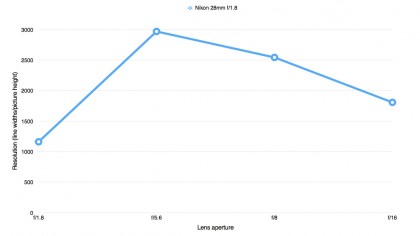TechRadar Verdict
Wide-aperture vignetting is more noticeable than in Nikon's 24mm lens and it's not quite as sharp, but image quality is very good overall.
Pros
- +
Pros: Affordable price
- +
Fast autofocus with full-time manual override
- +
Good image quality
Cons
- -
Cons: Plastic rather than metal construction
- -
some vignetting
- -
No ED lens elements
Why you can trust TechRadar
Mount: Nikon F | Format: Full frame | Construction: 11 elements in 9 groups, 7 diaphragm blades | Closest focus distance: 25cm | Filter thread: 67mm | Autofocus: ring-type ultrasonic | Dimensions: 73x81mm, weight 330g | Tested on: Nikon D7100
This lens is nearly an f/stop slower than Nikon's 24mm f/1.4 lens, or rather two-thirds of a stop to be precise. It costs just one-third of the price, though, making it a much more affordable proposition for Nikon users who want a fast wideangle prime lens.
Along with the reduced wide-aperture ability there's also a reduction in the angle of view. Even so, the 28mm focal length gives a viewing angle of 75 degrees (measured on the diagonal) when used on a full-frame camera, compared with the 84 degrees of a 24mm lens. It's still a usefully wide lens for indoor and outdoor shooting alike, but loses out to the more generous wide-angle abilities of a typical 24-70mm standard zoom lens.
Like Nikon's 24mm lens, though, it only makes sense on a full frame Nikon body. On an APS-C model, the focal length effectively becomes 42mm, which is not wide at all.
The barrel construction is based on high-quality plastics rather than magnesium alloy and the lens doesn't feel as robust as the Nikon 24mm lens, but it's still well made nonetheless. There are two aspherical elements plus the application of Nano Crystal Coat and a weather-sealed mounting plate, but there are no ED (Extra low Dispersion) elements.
Performance
Nikon's ring-type ultrasonic autofocus system is every bit as fast as in the company's more exotic 24mm lens and, as usual, comes complete with full-time manual override. The manual focus ring is even larger than in the Nikon 24mm and equally smooth and precise in operation. Vignetting is more noticeable at the widest available aperture and sharpness isn't quite as excellent, but overall image quality is very good on the whole.
Test results
Sharpness: The sharpness chart provides an indication of lens performance across the focal range (for zoom lenses) and at different lens apertures.
Sign up for breaking news, reviews, opinion, top tech deals, and more.

The 28mm f/1.8 not quite as sharp as Nikon's flagship 24mm lens, especially at maximum aperture, but still does well to maintain good sharpness into the image corners.
Fringing: As with the Nikon 24mm f/1.4 lens, colour fringing is essentially a non-issue with the Nikon 28mm f/1.8.
f/1.8: 0.24
f/5.6: 0.25
f/8: 0.36
f/16: 0.22
Distortion: -1.3
Along with its more modest viewing angle, compared with Nikon's 24mm lens, comes a reduction in the amount of barrel distortion. Negative values indicate barrel distortion, positive values indicate pincushion distortion, and figures closes to zero are best.
Verdict: Wide-aperture vignetting is more noticeable than in Nikon's 24mm lens and it's not quite as sharp, but image quality is very good overall.
